Este post também está disponível em:
Português
English
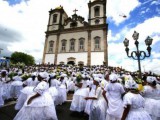
Religious tourism in Salvador takes place in the more than 300 secular churches.
It is often said in the city that there is a different church to visit every day of the year.
The Church of Bonfim, São Francisco, Conceição da Praia, Rosário dos Pretos and the Basílica Cathedral are some examples of the Catholic temples most visited by tourists.
The Igreja do Bonfim is known for the faith that Bahians have in the Lord of Bonfim. Inside the church, in the Sala dos Milagres (Miracle Room), devotees leave photos and replicas of human body parts in gratitude for a cure, after making promises and requests to the deity.
The famous Senhor do Bonfim ribbons are sold at the church door.
Devotees usually tie them around their wrist with three knots. For each knot, a request is made. The belief is that when the ribbon breaks, the requests have been answered.
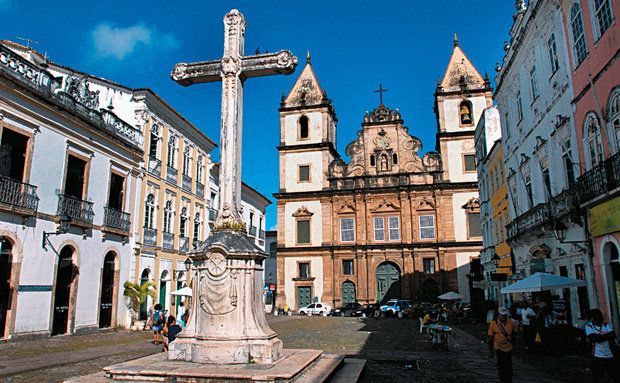

Igreja e Convento São Francisco de Assis em Salvador BA
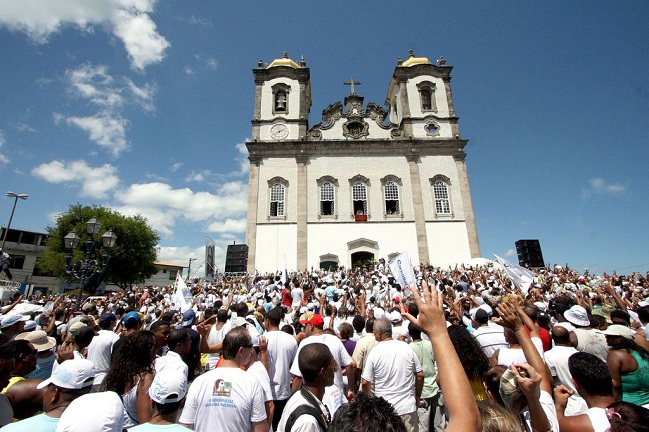
Turismo religioso em Salvador BA
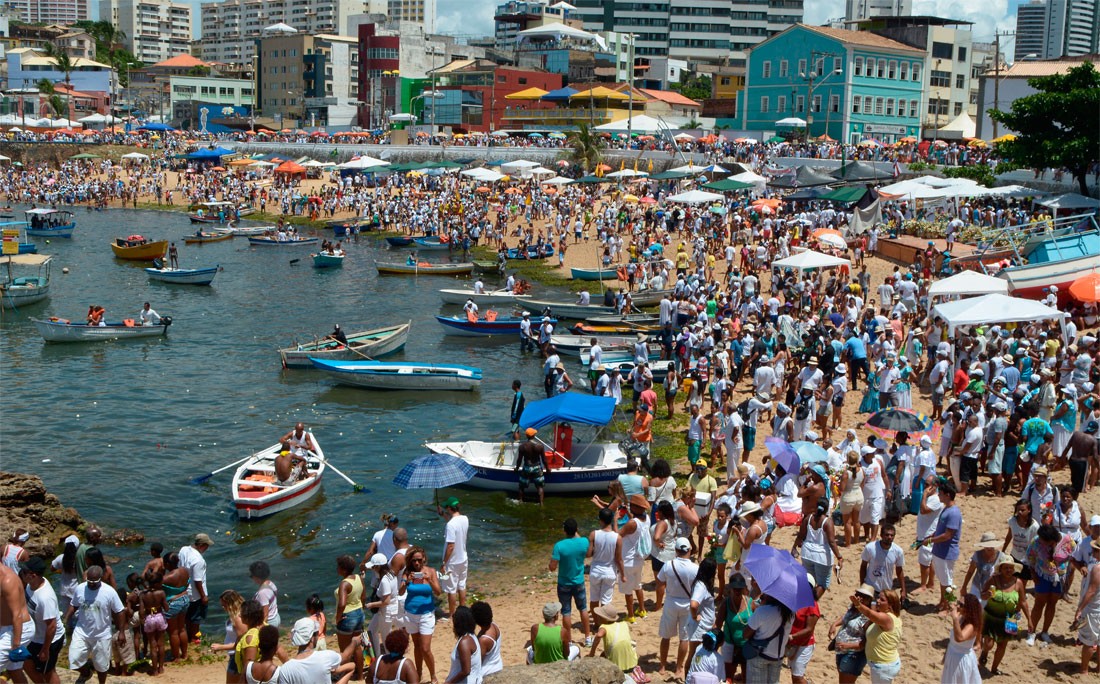
Turismo Religioso em Salvador na Bahia
In Terreiro de Jesus, Historical Centre of Salvador, you’ll find the Church of São Francisco, considered one of the richest and most beautiful in the country. Various materials were used in its construction, from lioz stone to gold for the interior panelling.
The baroque façade dates from 1723, as do the Portuguese tile panels. In the sacristy there are 18 oil panels on the life of St Francis.
Named “The Paths of Faith in the City of Salvador”, the circuit developed in partnership with the Pastoral of Tourism of the Archdiocese of Salvador includes churches, monasteries, convents and shrines in the capital, offering visitors the opportunity to get to know the sacred art and history behind each space;
Religious Tourism in Salvador
1. 3 Routes for religious tourism
1. The “Charity and Faith” Route
Includes the Conceição da Praia Basilica Shrine, Nossa Senhora do Pilar and Santa Luzia Churches, Salvador Monastery, Nossa Senhora dos Alagados and São João Paulo II Parishes, Santa Dulce dos Pobres Shrine, Senhor do Bonfim Basilica Shrine, Nossa Senhora dos Mares Parish, Nossa Senhora da Boa Viagem Parish, Nossa Senhora da Penha Parish.
2. Art and Faith Route
It includes the Monastery of São Bento, Ajuda Church, Misericórdia Church and Museum, Palácio Arquiepiscopal Cultural Centre, Salvador Basilica Cathedral, São Bento dos Clérigos Church, São Domingos de Gusmão Church, São Francisco Convent and Church, Igreja da Ordem 3ª de São Francisco, Igreja da Nossa Senhora do Rosário dos Pretos, Igreja do Santíssimo Sacramento do Passo, Igreja da Ordem 3ª do Carmo, Igreja de Nossa Senhora do Carmo, Igreja de Nossa Senhora do Boqueirão and Igreja de Santo Antônio Além do Carmo.
3. Monastery and Convent Tour
You can visit the Convent of Nossa Senhora do Desterro and the Devotion to the Servant of God Vitória da Encarnação, the Church of Santíssimo Sacramento and Santana, the Church and Convent of Nossa Senhora da Conceição da Lapa, the Sanctuary of Nossa Senhora da Piedade and the Capuchin Memorial, the Chapel of Blessed Lindalva Justo, the Church of São Raimundo, the Church of São Pedro and the Monastery of São Bento;
2. Beatification of Sister Dulce
With the announcement of Sister Dulce’s beatification, the number of tourists coming to Salvador in search of religious tourism promises to increase greatly, even after Pope Benedict XVI signs off on the process, which should happen by December.
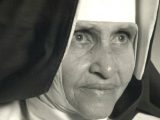
For Osvaldo Gouveia, Memory and Culture Advisor for the Sister Dulce Social Works, not only will the works gain visibility with the beatification, but the beauty of the Itapagipana Peninsula and the 11 places where Sister Dulce passed through and spread her charity and love for her neighbour will also be honoured by visitors from all over the world.
One example is the Feira de São Joaquim, which is in the process of being revitalised, where the local traders were the first to collaborate with the works of the nun.
The fame of the nun’s virtues attracts thousands of visitors every year who are interested in learning more about the life and work of Sister Dulce, on display at the Sister Dulce Memorial;
In addition to the exhibition, visitors can extend their visit to the Church of the Immaculate Conception of the Mother of God, where the relics of Venerable Dulce are currently housed, the shop, where they can buy T-shirts, brooches, rosaries, bracelets and various other products with images of the nun, and get to know some of the institution’s service centres.
The nun is the first Bahian to become a Blessed and is only one step away from canonisation. To be canonised, two more miracles interceded by Sister Dulce and recognised by the Vatican will have to be proven.
3. Iemanjá festival is one of the most popular in Brazil
The Festa de Iemanjá is also part of religious tourism.
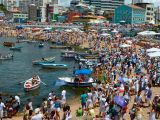
Fishermen and the faithful celebrate in a maritime procession, which sets out to sea from 4pm in countless boats, carrying flowers and other gifts for the Queen of the Waters. This is one of the biggest public religious manifestations of candomblé.
The streets of the Rio Vermelho neighbourhood are filled with people who flock to watch the boats leave with the offerings. This event has been taking place since 1974, organised by the fishermen of the neighbourhood’s fishing colony.
Iemanjá is often represented in the Latinised form of a mermaid, with long hair blowing in the wind. They also call her Dona Janaína or Queen of the Sea.
In 1923 they went out on the second of February to offer gifts to the queen of the waters.
Year after year the fishermen repeated this ceremony. At first it was done in conjunction with the Parish of Rio Vermelho, due to the syncretism between the orisha and Our Lady of the Conception.
In the 1960s, the Catholic Church reacted against the pagan cult, causing the festival to officially lose its devotion to the Catholic saint.
The Church of Santana, located on the same site as the festival, always keeps its doors closed on 2 February.
Nowadays, the tributes to this orisha begin at dawn, with devotees from Candomblé, Umbanda and Catholicism placing offerings and notes with requests in rafts that will be taken to the high seas.
These rafts are carried by around 300 boats, with the sloop carrying the fishermen’s offerings always at the head of the procession.
People of all religions celebrate in the same way, bringing flowers, perfume, champagne and candles, but some people have never heard of the legend of Iemanjá. The purpose of the festival is to please the queen of the sea, in the hope that she will bless fishermen more and more.
4. Main churches in Salvador BA
We’ve listed some of these churches so you can learn a little more about the history and religiosity left by our Portuguese colonisers.
1. Igreja e Convento de São Francisco
The church and convent of São Francisco is located in the heart of Pelourinho, the church was chosen as one of the Wonders of the Portuguese Baroque in the world and is one of the most unique and rich expressions of the Brazilian Baroque.
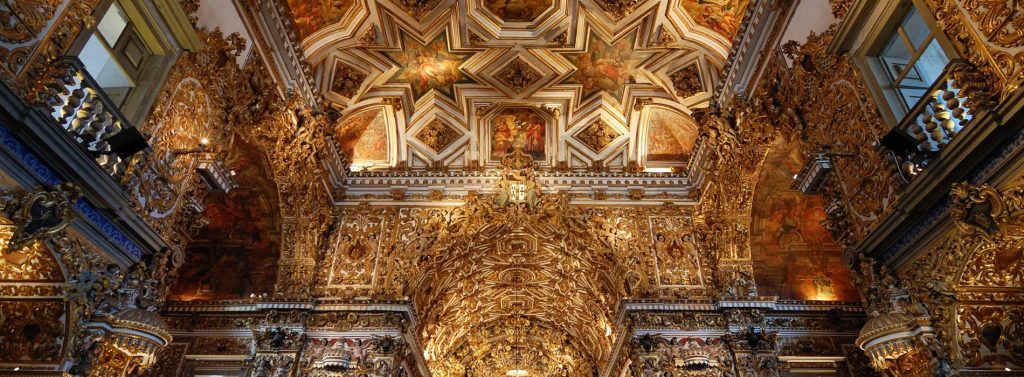
The structures were built between the 17th and 18th centuries and feature, especially the church, spectacular interior decoration with panelling and a gold-plated altar.
The site also houses the only collection of Portuguese tiles depicting the city of Lisbon, Portugal, before the 1755 earthquake.
Visitors can visit the church every day from 9am to 5pm.
Location: Rua da Ordem Terceira, Pelourinho, Historic Centre
2. Church of Nossa Senhora do Rosário dos Pretos
Built by slaves who didn’t have a place to celebrate their beliefs, the church today is a space for intercultural dialogue, with beautiful celebrations that use elements of Afro-Brazilian culture, characterised by syncretism involving Catholic religions and those of African origin, such as Candomblé.
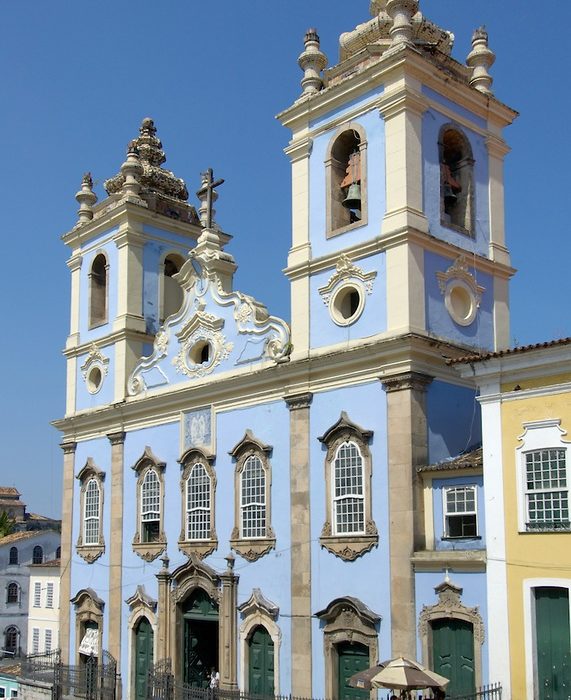
At the masses, which are always held on Tuesday evenings, atabaques are the instruments used to sing the songs.
Visiting: The church can be visited from Monday to Friday, from 8am to 5pm. On Saturdays, it is open until 12 noon.
Location: Largo do Pelourinho, 25, Pelourinho.
3. Igreja da Ordem Terceira do Carmo
Built between 1788 and 1803, it stands next to the church of the first order, on Ladeira do Carmo, in the historic centre of Salvador. It was built in the Baroque style, with Gothic details.
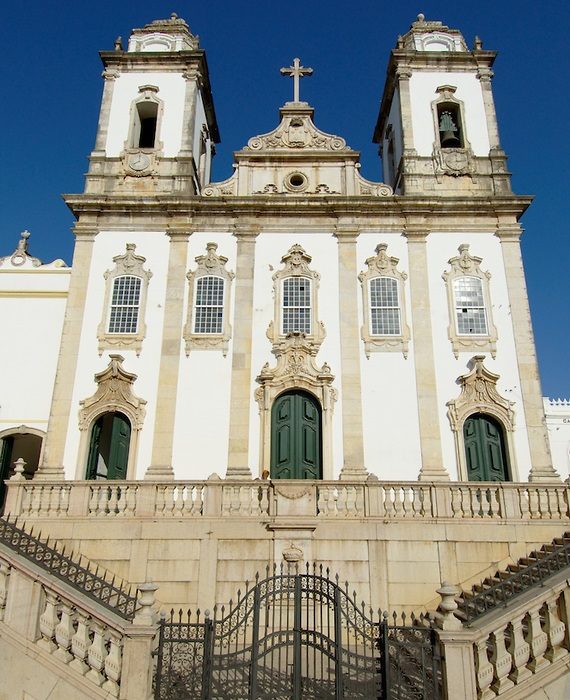
It houses the cedar image of the Dead Lord, with two thousand ruby stones, sculpted in 1730 by the slave Francisco das Chagas, considered the “Aleijadinho of Bahia”. Its staircases are traditionally used for photographing university graduates.
The convent next door was bought by a hotel chain and houses some of the most expensive accommodation in Salvador.
Visiting: The church can be visited from Monday to Friday, from 7am to 5pm.
On Saturdays, it is open until 12 noon. There is no information on the cost of the visit. Location: Rua do Carmo, 01, Carmo. Telephone: (71) 3242-0182.
4. Catedral Basílica de Salvador
The current Cathedral Basilica of Salvador is the fourth to be built on the same site. Its foundation stone was laid in 1657 and it was inaugurated and consecrated in 1672, but it wasn’t quite ready yet.
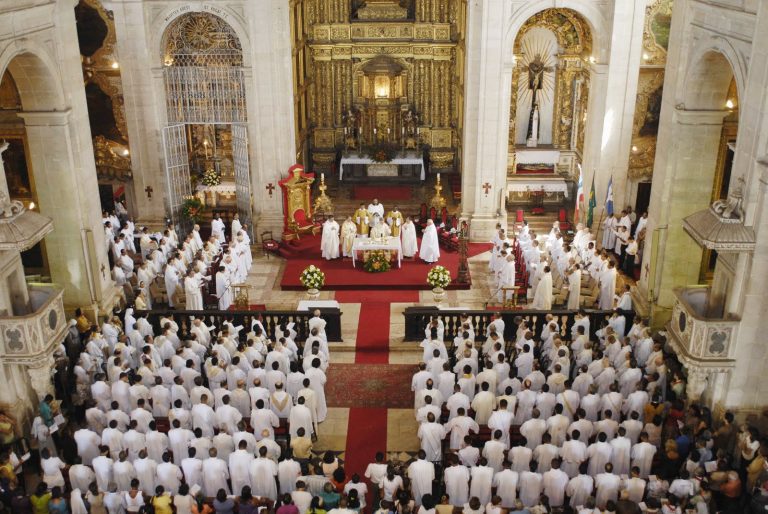
Visiting: The Cathedral is open on Saturdays and Sundays from 8am to 6pm, with a visitation fee of R$5, except during mass.
Location: Terreiro de Jesus Square, Pelourinho.
5. Venerável Ordem Terceira São Domingos Gusmão
Located in Terreiro de Jesus, in Pelourinho, right opposite the Basilica Cathedral, the Church of the Venerable Third Order of São Domingos Gusmão began construction in 1731.

The façade is in rococo style and the interior has neoclassical carvings, which replaced the original baroque carvings.
Visits: The church can be visited from Monday to Friday.
Location: Largo Terreiro de Jesus, 19, Pelourinho.
6. Igreja da Ajuda
The first Ajuda Church was built in 1549, during the construction of the city of Salvador by Governor-General Tomé de Sousa.
Its builders were the Jesuits, led by Manuel da Nóbrega, who erected a precarious little church with wattle and daub walls covered in straw. It was located within the precincts of Salvador, a city that at the time was surrounded by a palisade to protect the settlers. It was dedicated to Our Lady of Help, which was the name of one of the ships in Tomé de Sousa’s fleet.
Visiting: The church can be visited from Monday to Friday, from 8am to 5pm, free of charge. Location: Rua do Tesouro, 62-128, Centre.
7. Igreja de Nossa Senhora da Conceição da Praia
Built in 1623, this is one of the oldest parishes in the Archdiocese of São Salvador. Located at the foot of the mountain that links the Upper City to the Lower City, its first church was built by order of the first governor-general of Brazil, Tomé de Sousa.
Its current Baroque style building was made entirely of soapstone brought from Portugal.

The procession of one of Bahia’s main religious festivals, the Bonfim Festival, which is celebrated in January, leaves the temple. The procession ends at the Church of Senhor do Bonfim.
Visiting: There is no information on visiting times, but the temple follows the liturgical and festival programme of the Catholic Church. Location: Rua da Conceição da Praia, Comercio.
8. Igreja do Santíssimo Sacramento do Passo
The church, of remarkable architectural merit, was built on a steep slope. It has a floor plan typical of Bahian churches from the early 18th century, with side aisles, tribunes and choir on the upper floor and a transversal sacristy.

There is an ossuary in the basement. Its altars and altarpieces, in neoclassical style, date from the mid-19th century. It has images of St Joseph, Our Lady of the Conception and Our Lady Mother of Men.
The famous scenes from the miniseries “O Pagador de Promessas” (1988), based on the play of the same name by Dias Gomes, were filmed on the staircase.
Visiting: No information on visits. Location: Rua do Passo, 54, Santo Antônio Além do Carmo.
9. Santuário da Bem-Aventurada Dulce dos Pobres

Bahia’s best-known nun, for her legacy of love for the poor, has a shrine entirely dedicated to her.
The site houses the tomb of the “Good Angel of Brazil” and a memorial that tells the story of Sister Dulce and her social works.
Visitation: Open daily from 7am to 6pm. Location: Avenida Bonfim, 161, Largo de Roma.
10. Igreja de Nossa Senhora dos Alagados e São João Paulo II
Inaugurated by Pope John Paul II in 1980, the church was built in a contemporary architectural style, clad in exposed bricks that draw rectangular and circular shapes.
The church is located in a peripheral neighbourhood of the Bahian capital (Alagados), which has already been visited by three great saints of our time: Saint John Paul II, Saint Teresa of Calcutta and Blessed Dulce of the Poor.

Visiting: The church can be visited on Thursdays between 7am and 5pm. On other days, visitors must book by calling (71) 3314-5087.
Location: Rua Luiz Régis Pacheco, in the Alagados neighbourhood of Uruguai.
Bahia.ws is the largest travel and tourism guide for Bahia and Salvador
Religious Tourism in Bahia



















